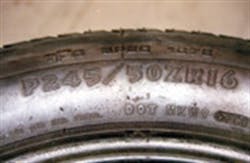Built, and repaired, for speed: Performance tires require special consideration
This article is part of a regular, exclusive series on passenger, light truck and commercial tire service, repair and training produced for Modern Tire Dealer by Kevin Rohlwing, senior vice president of education and technical services for the Tire Industry Association (TIA).
There are a lot of issues to address when repairing speed-rated tires. Some tire manufacturers allow nail hole repairs in the crown area while others do not. If a tire manufacturer nullifies the speed rating after a repair, the tire should not be returned to the vehicle.
Fortunately, the waters are muddy on this issue. Why is one speed-rated tire repairable and another is not? (As an example, the tire in the photo, a size P245/50ZR16 Goodyear Eagle ZR50, if repaired properly, can retain its Z speed rating.) Aren't speed-rated tires basically the same from a construction standpoint? Does the repairable speed-rated tire have special components and a magical design that allow it to retain the original speed rating following a repair? Is the repairable speed-rated tire that much better than the one that cannot be repaired?
You can bet that technicians from the tire repair material manufacturer are going to join you at the defense table when a repaired speed-rated tire is the alleged cause of an accident. They have ample data and test wheel results that prove properly installed nail hole repairs within recommended limits for size and location do not weaken the structural integrity or speed rating of a speed-rated performance tire.
By definition, a repair restores the original condition, so the original speed rating is retained. The key words are "properly installed."
Tire repair materials have taken adhesion and vulcanization to another level when nail hole repairs are installed according to specifications. The bond between the components and the tire is often as strong, if not stronger, than the bond between the innerliner and body cords. In other words, you'll rip the innerliner out of a tubeless tire before you separate it from a fully cured repair unit.
By following the tire repair material manufacturer guidelines for installing the nail hole repair unit, tire dealers give themselves an important ally in the event of an accident. If a speed-rated tire is properly repaired, the original condition and speed rating should be restored.
Technician training becomes even more important in an area like this where the margin for error is so small. Educated technicians understand size and location limitations, so they never install nail hole repairs in the shoulder or sidewall.
Educated technicians always remove the damaged material from the injury and fill the void with a rubber stem. Educated technicians never repair tires on the wheel because they recognize the importance of inspecting the inside of the tire.
When these and other key points represent primary objectives in the documented tire repair training program that every technician should be required to complete, it's easier to prove that a repair was properly installed and that some form of quality control exists.
On the other hand, when companies have no proof that employees have been properly trained to repair performance tires, they are at the mercy of the plaintiff because quality control is impossible to prove without some sort of established guidelines and procedures.
Tire repair material manufacturers have been industry leaders in technician education for decades and many of them will conduct hands-on training programs in the field. TIA has a nail hole repair training program that also can be used to provide documented proof of training. There's really no excuse for allowing technicians to repair performance tires without the proper training on procedures, guidelines and limitations. If your company repairs tires of any kind, documented proof of employee training is often the first and last line of defense in the event of an accident.
About the Author

Bob Ulrich
Bob Ulrich was named Modern Tire Dealer editor in August 2000 and retired in January 2020. He joined the magazine in 1985 as assistant editor, and had been responsible for gathering statistical information for MTD's "Facts Issue" since 1993. He won numerous awards for editorial and feature writing, including five gold medals from the International Automotive Media Association. Bob earned a B.A. in English literature from Ohio Northern University and has a law degree from the University of Akron.
